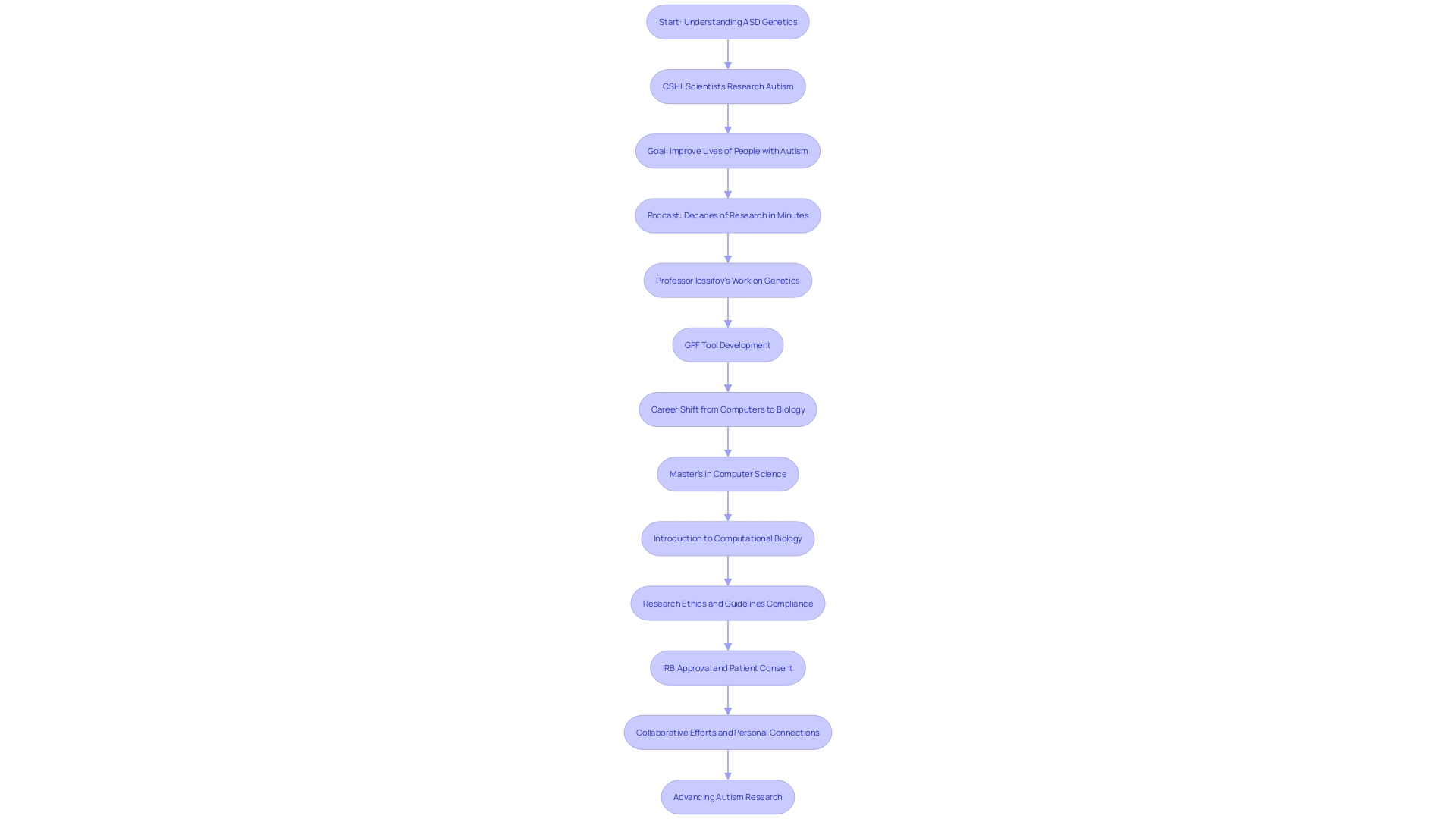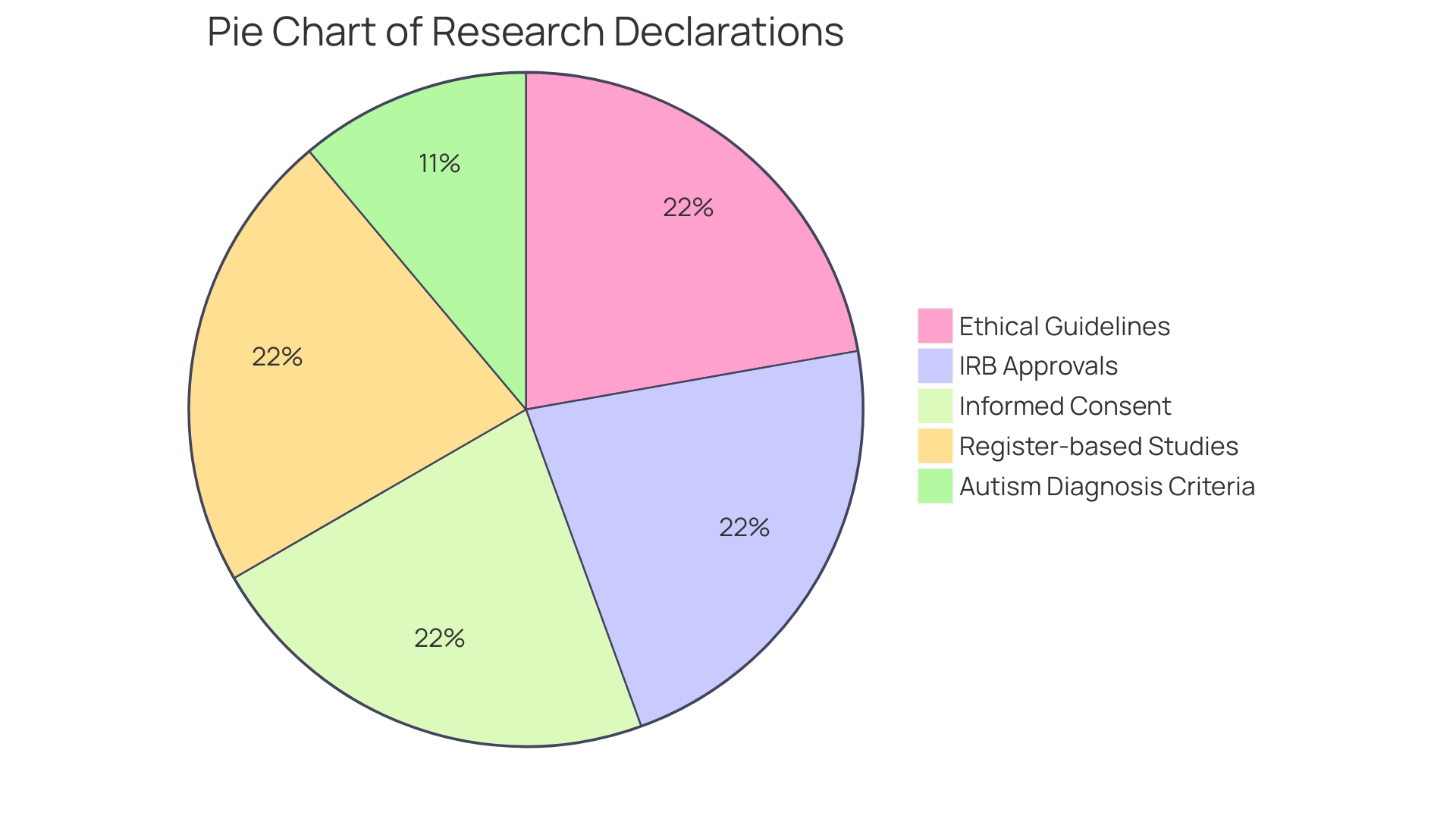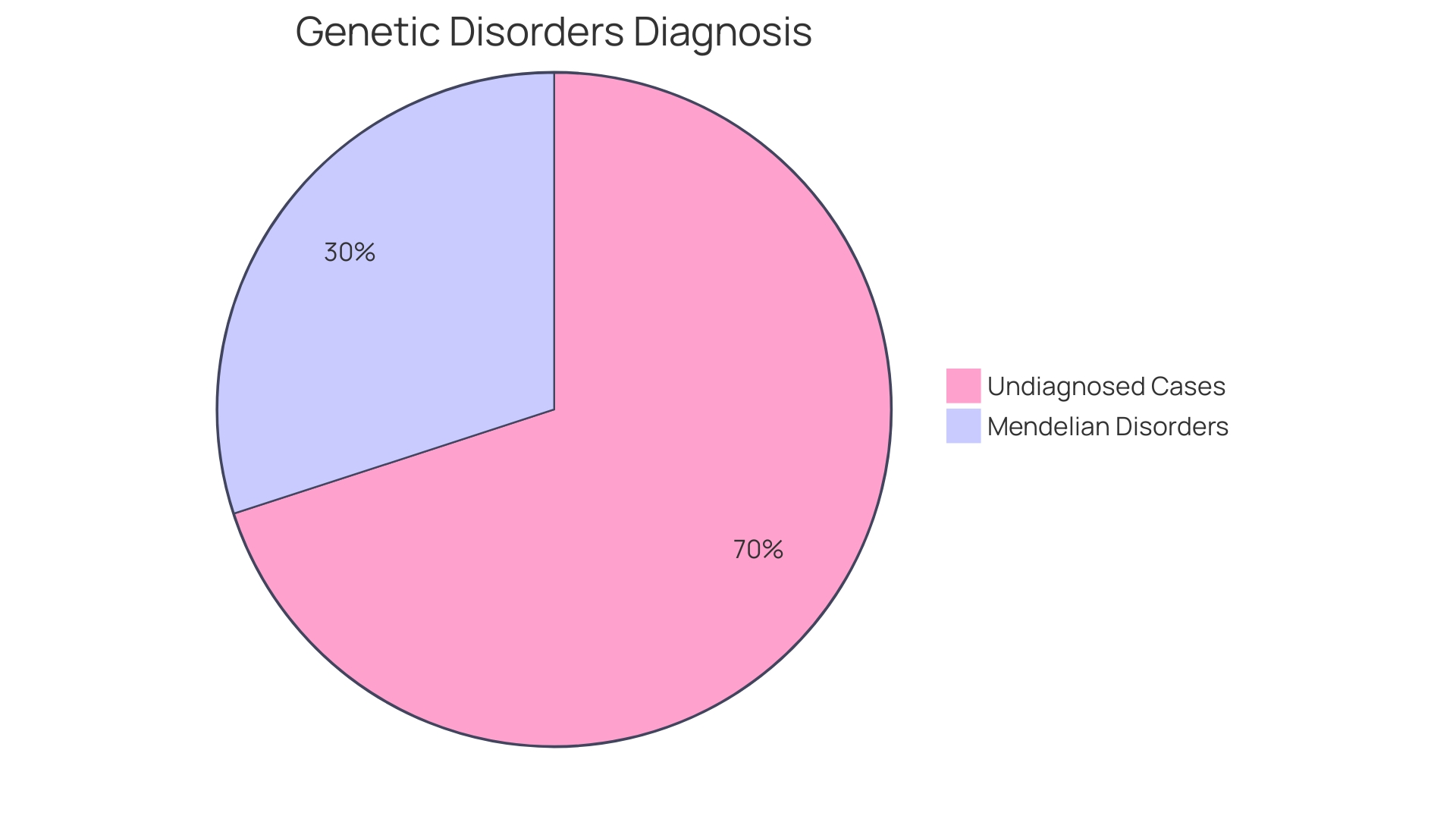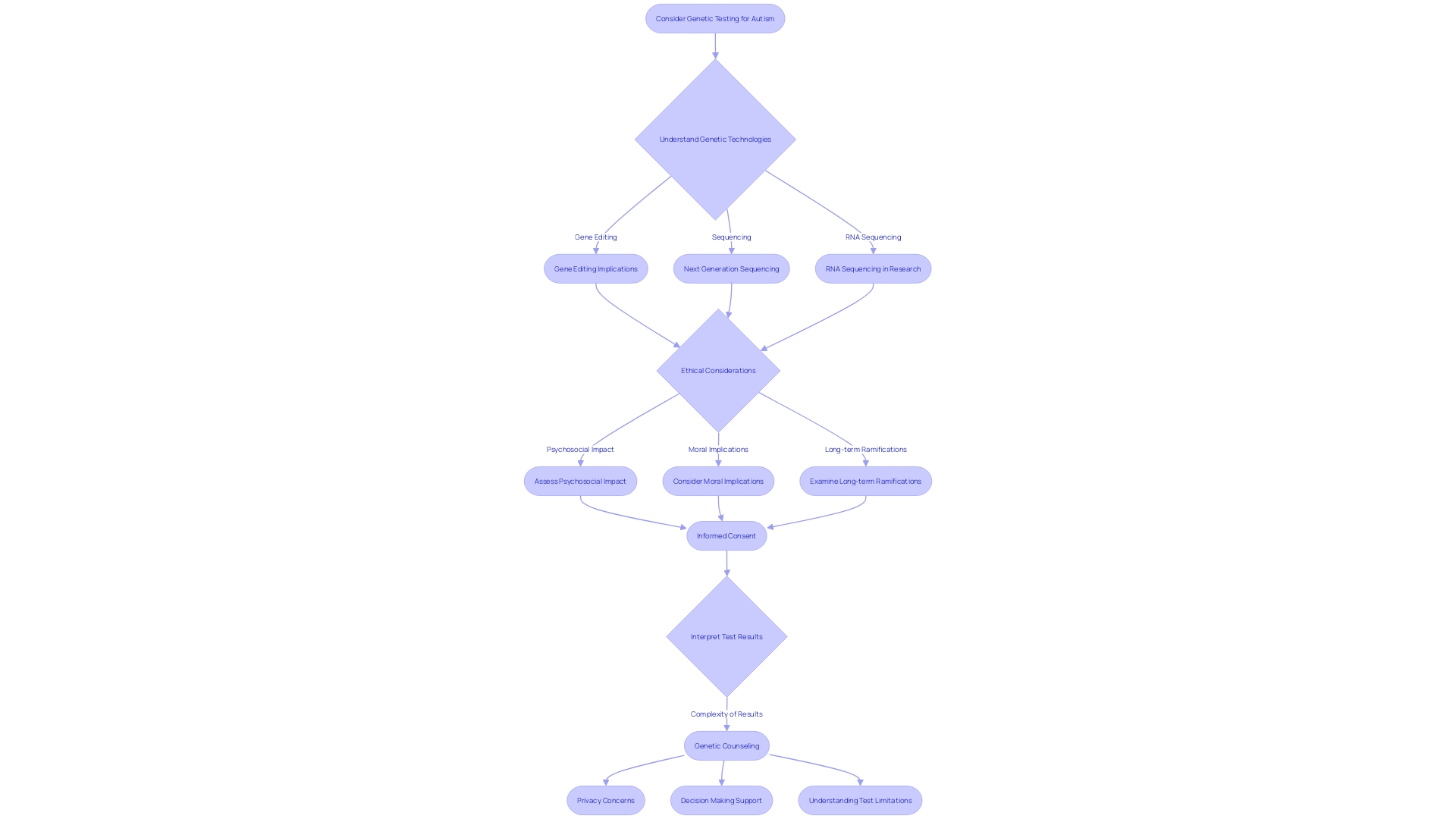Introduction
Delving into the genetic landscape of autism spectrum disorder (ASD), recent research has been pivotal in illuminating the intricate genetic contributors that shape this complex condition. With each study, we edge closer to understanding the genetic tapestry of ASD, a pursuit that not only reveals the disorder's roots but also opens doors to potential therapeutic avenues. The innovative research at Cold Spring Harbor Laboratory exemplifies the commitment to unraveling autism's genetic mysteries.
Moreover, a groundbreaking study has provided a molecular map, the first of its kind for any neuropsychiatric disorder, which details the molecular mechanisms in individuals with ASD carrying specific genetic mutations. In an era where technological advancements like AI are propelling scientific discovery forward, the integration of quantitative biological methods is reshaping our approach to studying complex conditions like autism. The commitment to this research is deeply personal for many in the field.
As the year 2023 has shown, the fusion of disciplines is pushing the boundaries of our knowledge. The contributions from dedicated researchers, ethical oversight, and the involvement of the autism community ensure that our journey towards demystifying autism is both responsible and inclusive. This collective journey is more than a scientific endeavor; it's an ongoing mission to improve the lives of individuals with autism and their families, motivated by both personal connections and the unyielding quest for knowledge.
Historical Context and Progress in Autism Genetics
Delving into the genetic landscape of autism spectrum disorder (ASD), recent research has been pivotal in illuminating the intricate genetic contributors that shape this complex condition. With each study, we edge closer to understanding the genetic tapestry of ASD, a pursuit that not only reveals the disorder's roots but also opens doors to potential therapeutic avenues.
For instance, the innovative research at Cold Spring Harbor Laboratory (CSHL) exemplifies the commitment to unraveling autism's genetic mysteries. Professor Iossifov, who pivoted from a background in computer science to the forefront of computational biology, has developed the Genotypes and Phenotypes in Families (GPF) tool. This resource could revolutionize the way researchers uncover new facets of autism's genetic origins.
Moreover, a groundbreaking study dubbed 'A Foundational Autism Protein Interaction Atlas' has provided a molecular map, the first of its kind for any neuropsychiatric disorder, which details the molecular mechanisms in individuals with ASD carrying specific genetic mutations. This atlas is a milestone, heralding the advent of new treatments tailored to the genetic underpinnings of ASD.
In an era where technological advancements like AI are propelling scientific discovery forward, the integration of quantitative biological methods is reshaping our approach to studying complex conditions like autism. As we amalgamate data from various domains—ranging from genetics to brain imaging—the potential to uncover novel connections is immense. For instance, a recent collaboration has led to the development of transport-based morphometry (TBM), a technique that reveals brain structure patterns linked to genetic variations known as 'copy number variations,' which are strongly associated with autism.
The commitment to this research is deeply personal for many in the field. Stories like that of a researcher inspired by their sister's unique developmental journey underscore the profound impact that personal experiences can have on scientific exploration.
As the year 2023 has shown, the fusion of disciplines, from AI to synthetic biology, is pushing the boundaries of our knowledge. The contributions from dedicated researchers, ethical oversight, and the involvement of the autism community, as seen with the Interagency Autism Coordinating Committee (IACC), ensure that our journey towards demystifying autism is both responsible and inclusive.
This collective journey is more than a scientific endeavor; it's an ongoing mission to improve the lives of individuals with autism and their families, motivated by both personal connections and the unyielding quest for knowledge.

Genetic Basis of Autism: Heritability and Genetic Variants
Understanding the genetic landscape of autism spectrum disorder (ASD) is essential for grasping its complexities. Heritability, in the context of ASD, refers to the proportion of observed variation in the disorder that can be attributed to genetic factors. Studies, such as those approved by the Danish Data Protection Agency, underscore the importance of this concept, highlighting that ASD shares genetic architecture with other psychiatric conditions. In fact, there is a notable overlap between the genetic variants linked to autism and those associated with other common psychiatric disorders.
Research published in reputable cohort studies indicates that both maternal and paternal psychiatric conditions can influence the risk of ASD in offspring, suggesting a complex pattern of genetic and environmental interplay. This complexity is further evidenced by the National Institutes of Health's curated list of genes associated with mental health traits, which includes statistically significant variants linked to ASD. These genetic variants play a significant role in individual susceptibility to the disorder.
Investigations into the genetic underpinnings of ASD continue to evolve, with tools like Genotypes and Phenotypes in Families (GPF) paving the way for new discoveries. As highlighted by experts at Cold Spring Harbor Laboratory, the ultimate goal of this research is to enhance the lives of individuals with autism and their families by deepening our understanding of the condition's genetic roots.

Types of Genetic Variants in Autism
Autism Spectrum Disorder (ASD) is influenced by a spectrum of genetic variations, each playing a role in the multidimensional nature of the condition. Among these variations, Copy Number Variants (CNVs) and Single Nucleotide Variants (SNVs) stand out for their prevalence and impact. CNVs involve duplications or deletions of larger DNA segments, potentially disrupting the function of crucial genes associated with ASD. SNVs, the alteration of a single DNA building block, can lead to subtle yet significant changes in gene expression or protein function. In addition to CNVs and SNVs, structural variations in the genome also contribute to the genetic architecture of autism, further underscoring the condition's complexity. These genetic insights are paramount in advancing our understanding of autism and guiding research towards more targeted interventions.
Advances in Genomic Technologies and Bioinformatics
The intricate puzzle of autism spectrum disorder (ASD) is being pieced together through groundbreaking genetic research, facilitated by state-of-the-art genomic technologies. Sophisticated tools like next-generation sequencing (NGS) and microarray analysis have become instrumental in deciphering the genetic underpinnings of ASD. NGS, for example, detects various genomic alterations with high precision, including single nucleotide variants and more complex chromosomal rearrangements. This technology's adaptability allows for high-throughput analysis, enabling the simultaneous sequencing of multiple samples, a boon for large-scale studies.
Illumina DNA sequencing systems exemplify this progress, offering a range of sequencing capabilities that cater to different laboratory needs. These advancements are not just enhancing throughput but are also driving down the cost of whole-genome sequencing. This method, viewed as the gold standard for genomic analysis, provides a comprehensive overview of an individual's entire genetic makeup, laying bare the contributions of both coding and non-coding regions of the genome to ASD.
Targeted resequencing is another approach gaining traction, where the focus is narrowed to specific genes or genomic regions of interest. This strategic selection streamlines the research process, conserving time and resources while still yielding critical insights. The utility of these approaches is evident in the work of researchers like Rohde and Kundu, who have leveraged transport-based morphometry to uncover brain structure patterns that correlate with genomic variations linked to autism.
This genetics-first approach is reshaping our understanding of ASD, as highlighted by Rohde and his collaborators in a study published in Science Advances. Their innovative technique helps distinguish normal brain structure variations from those associated with autism, particularly copy number variations where DNA segments are either deleted or duplicated.
The pursuit of understanding the genetic landscape of ASD has also led to remarkable findings in non-coding regions of the genome, such as promoters, which regulate gene expression. Atsushi Takata and his team at RIKEN CBS have delved into 'de novo' gene variants in these regions, analyzing an extensive dataset of over 5,000 families. Their research represents one of the largest genome-wide studies of ASD to date, emphasizing the complexity of genetic contributions to the disorder.
Complementing these scientific endeavors, the Genomic Medicine Working Group of the NHGRI curates significant genomic research, selecting notable papers that reflect the year's advancements. These selected studies, including those on ASD, serve as milestones marking our journey towards a more profound comprehension of the genetic factors at play.
Furthermore, the efforts of scientists at institutions like Cold Spring Harbor Laboratory underscore the ultimate goal of autism research: to improve the lives of individuals with ASD and their families. Tools like Genotypes and Phenotypes in Families (GPF), developed by researchers like Professor Iossifov, are paving the way for future discoveries and the development of novel therapeutic interventions.
In sum, the evolution of genomic technologies and bioinformatics is revolutionizing autism research, offering new windows into the genetic basis of the disorder and inspiring hope for more targeted, effective interventions.

Current Genetic Testing Methods for Autism
Genetic testing has emerged as a crucial element in understanding and diagnosing autism spectrum disorder (ASD). Clinicians now have a suite of sophisticated genetic testing techniques at their disposal. Chromosomal microarray analysis (CMA) is often the first-line genetic test recommended for individuals with developmental delays, intellectual disabilities, or ASD. This method detects copy number variations—deletions or duplications of DNA segments known to be associated with ASD. Whole exome sequencing (WES) goes further, examining the protein-coding regions of genes to unearth rare genetic mutations that could underlie ASD. Additionally, targeted gene panel testing zeroes in on specific genes already associated with autism, offering a more focused approach.
The significance of early and accurate diagnosis of ASD cannot be overstated. Organizations like The Autism Community in Action (TACA) advocate that starting behavioral therapy promptly can lead to more favorable outcomes for children with autism. Unfortunately, conventional diagnostic methods may yield results belatedly or miss the mark entirely, underscoring the need for more efficient diagnostic tools. In response, NeuroQure is trailblazing with gene therapy advancements that could significantly shorten the diagnosis timeline for ASD.
Innovations in computational biology are also contributing to this field. A new tool, Genotypes and Phenotypes in Families (GPF), presents the possibility for groundbreaking discoveries about autism's genetic origins. With the development of machine-learning models like AutMedAI, researchers are now able to identify autism in children under two years old with about 80% accuracy, utilizing a combination of 28 different parameters obtainable without extensive assessments or medical tests before the age of 24 months.
The ethical considerations in genetic research for autism are paramount, with strict adherence to guidelines, IRB approvals, and patient consent processes, as seen in studies approved by agencies like the Danish Data Protection Agency.
In summary, genetic testing methods such as CMA, WES, and targeted gene panel testing are instrumental in the early identification of ASD, which can lead to timely interventions and better outcomes for affected children. Advancements in gene therapy and computational biology hold the promise of revolutionizing autism diagnosis and treatment, ensuring that the journey towards understanding autism's genetic underpinnings continues with both ethical integrity and scientific rigor.
Clinical Applications of Genetic Testing in Autism
Genetic testing is a transformative tool in the landscape of autism spectrum disorder (ASD), offering more than just a path to diagnosis. It paves the way for tailored clinical management and individualized intervention strategies. With the potential to uncover associated comorbidities and aid in prognosis, genetic testing is a key component in crafting personalized treatment plans for those with ASD. Institutions like Baylor Genetics are at the forefront of this precision medicine, providing a comprehensive range of genetic testing services that can inform and improve patient care.
The importance of early and accurate diagnosis of ASD is echoed by organizations such as The Autism Community in Action (TACA) and NeuroQure, which emphasize the benefits of early intervention. As TACA supports thousands of families across the United States, they've observed firsthand how timely treatment, such as behavioral therapy, can significantly alter the trajectory of a child's development. NeuroQure's recent advances in gene therapy for neurocognitive disorders, including the acquisition of a vital patent portfolio from UC Irvine Center for Autism Research and Translation, underline the urgency for prompt and precise diagnostic tools.
Supporting this, research underscores the genetic underpinnings of ASD, suggesting that a genetics-first approach could revolutionize our understanding and treatment of the condition. This is highlighted by a paper in Science Advances, which outlines how cutting-edge mathematical modeling techniques can identify brain structure patterns associated with genetic variations linked to autism.
Ethical considerations remain paramount in the utilization of genetic testing in research and clinical settings. All necessary protocols, including IRB approvals and patient consent, are stringently followed, ensuring that the privacy and rights of individuals are safeguarded, as seen in studies approved by the Danish Data Protection Agency.
The insights from genetic testing are not just clinical; they resonate with the stories of families navigating ASD. As Professor Iossifov of Cold Spring Harbor Laboratory, a pioneer in autism genetics research, has demonstrated with tools like Genotypes and Phenotypes in Families (GPF), understanding the genetic landscape of autism can lead to groundbreaking discoveries that have the potential to improve the lives of individuals with ASD and their families.
Challenges and Future Directions in Interpreting Genetic Test Results
Navigating the landscape of genetic testing and its implications for autism spectrum disorder (ASD) is complex. Genetic tests can reveal a myriad of variants, but interpreting these results requires a nuanced understanding of their significance. For instance, a variant of uncertain significance (VUS) might be identified, which doesn’t clearly indicate whether it is benign or pathogenic. This uncertainty necessitates a collaborative approach among medical professionals across disciplines to interpret these findings within the broader context of the individual’s health and family history.
Moreover, as we push the boundaries of genetic research, continuous improvements in the accuracy and interpretation of these tests are crucial. The journey of Emily, who discovered her predisposition to type 2 diabetes through genetic testing, underscores the importance of preemptive health strategies. It shows how genetics can inform individual health risks and prevention plans.
The developments at NeuroQure signal a new era in ASD diagnosis. Their work, building on the foundational research by Dr. John Jay Gargus, aims to shorten the diagnostic journey for ASD—a journey that can span over five years. The acquisition of a patented portfolio from the UC Irvine Center for Autism Research and Translation marks a significant step towards creating precise diagnostic tools for ASD, highlighting the importance of early and accurate diagnosis.
It's imperative that any research and clinical trials adhere to strict ethical guidelines and obtain necessary approvals, as demonstrated by the study approved by the Danish Data Protection Agency. Such rigorous standards ensure that the advancements in genetic testing and screening for ASD are both responsible and effective in aiding early intervention strategies, which have been shown to improve outcomes for affected individuals.
Ethical Considerations and Genetic Counseling
Genetic testing for autism raises profound ethical questions that require careful consideration. The possibility of such testing becoming widespread invites us to ponder the long-term ramifications, as echoed by voices within the community who ask, "What on earth have we done?" after four decades. This concern is not unfounded, especially when one considers the potential psychosocial impacts on individuals and families. For instance, parents planning to have children might contemplate tests to detect health challenges, including Down syndrome, but grapple with the moral implications of using this information to make life-altering decisions.
The ethical landscape of genetic testing is also shaped by privacy concerns and the requisites of informed consent. With the increasing ability of Non-Invasive Prenatal Testing (NIPT) to screen for various conditions, the burden of 'knowledge as power' takes on new weight. When faced with a high-risk result, understanding the context is crucial—what population and measures were used to define this risk? These questions highlight the complexity of interpreting test results and the ethical dilemmas they pose.
It is essential to recognize the responsibility that comes with handling sensitive genetic information. This is underscored by research approved by ethical bodies like the Danish Data Protection Agency, which stipulates that patient and participant identifiers should remain confidential within research groups to protect individual identities.
Genetic counseling emerges as an indispensable resource amidst these complexities, offering guidance and support to families navigating the intricacies of autism genetic testing. The counsel provided helps families understand the potential outcomes and implications, ensuring they are equipped to make informed decisions with a clear grasp of the ethical landscape.

Integration of Genetic Testing into Clinical Care
The quest for personalized healthcare is leading to the integration of genetic testing into the clinical care of individuals with autism. With the complexity of autism spectrum disorder (ASD) being influenced by various genetic factors, the incorporation of genetic testing into routine practice stands at the forefront of enhancing patient care. Renowned institutions like Baylor Genetics and Children's National Hospital are trailblazers in this field, offering extensive genetic testing and counseling services that provide insights into the unique genetic makeup of individuals with ASD.
While autism is diagnosed based on behavioral criteria, genetic testing can pinpoint specific genetic alterations, helping to tailor interventions more effectively. It's not just about offering a diagnosis; it's about understanding the underlying genetic landscape that can influence treatment choices. For instance, Baylor Genetics' comprehensive testing capabilities are empowering clinicians with the knowledge required to confront complex cases, such as the one involving an 11-year-old boy with an abnormal gait.
The significance of early and accurate diagnosis cannot be overstated, as emphasized by organizations like The Autism Community in Action (TACA) and NeuroQure. Early intervention such as behavioral therapy is crucial for optimal outcomes, and efforts to create diagnostic tools that can identify ASD at the earliest possible age are ongoing. The impact of these advancements is monumental, potentially reducing the years-long odyssey to a mere few weeks for a diagnosis of ASD, especially in high-risk families.
Furthermore, the acquisition of a patent portfolio by NeuroQure from the UC Irvine Center for Autism Research and Translation signifies a leap forward in developing precise diagnostic tools. This innovative approach is set to revolutionize the understanding and management of ASD, supported by the profound research of Dr. John Jay Gargus and his team.
As we continue to unravel the genetic intricacies of autism, the essential role of genetic literacy among healthcare professionals becomes clear. They must navigate the complexities of genetic information to make informed decisions about testing and management. With the NHGRI's Genomic Medicine Working Group highlighting significant advances in genomic medicine, it's evident that the healthcare community must remain abreast of the latest developments to provide the best possible care for those with ASD. Collaborative decision-making, backed by a multidisciplinary approach, ensures that individuals with ASD and their families receive the support they need to navigate this multifaceted condition.
Conclusion
In conclusion, recent research has made significant strides in understanding the genetic landscape of autism spectrum disorder (ASD). The integration of AI and computational biology has reshaped our approach to studying ASD, leading to groundbreaking discoveries and the development of targeted interventions. Genetic variants, such as Copy Number Variants (CNVs) and Single Nucleotide Variants (SNVs), play a crucial role in individual susceptibility to ASD.
Advancements in genomic technologies, including next-generation sequencing and microarray analysis, have revolutionized our understanding of the genetic basis of ASD. These technologies offer new insights into the molecular mechanisms of ASD and inspire hope for more effective interventions. Genetic testing, such as chromosomal microarray analysis (CMA) and whole exome sequencing (WES), is instrumental in early identification and personalized treatment plans.
Ethical considerations, privacy concerns, and informed consent are of utmost importance in the utilization of genetic testing. Genetic counseling provides guidance and support to families navigating the complexities of autism genetic testing, ensuring they can make informed decisions.
The integration of genetic testing into clinical care is transforming the landscape of ASD, offering tailored management and individualized intervention strategies. Institutions like Baylor Genetics and Children's National Hospital are leading the way in providing comprehensive genetic testing services that inform and improve patient care.
In this collective journey, fueled by the quest for knowledge and the desire to improve the lives of individuals with ASD and their families, we are getting closer to understanding and managing ASD. The ongoing research, the involvement of the autism community, and the advancements in genetic testing bring us closer to our goal of demystifying autism and ensuring the well-being of individuals with ASD.
Together, we can navigate the challenges, embrace the power of genetics, and empower individuals with ASD and their families to lead fulfilling lives. The future holds promise as we continue to unravel the genetic complexities of ASD and work towards personalized interventions that make a meaningful difference.




